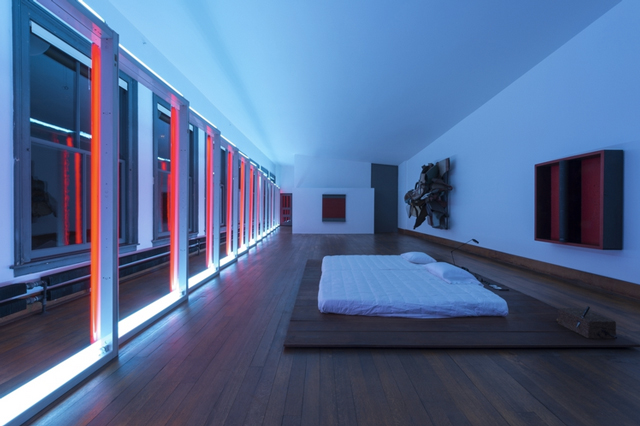July 22, 2013
Station Point Judd

Thanks to the generosity of collectors Michael and Sirje Gold (fellow recent transplants from LA to NYC, they made their home here near Wall Street), I was invited to accompany them on a tour of Donald Judd's cast iron district home in SoHo, now a museum. The building is nearly a mausoleum, with each turn up its five stories, I nearly expected to see a freeze dried body of the great artist. The building is nearly a shrine and Donald Judd has certainly been sainted, so my expectation is not that far fetched. To be able to see his body in a vitrine would at least be a wink and nod to the over the top adoration that art history is heaping upon Judd. Now, don't get me wrong, I do admire Donald Judd as an artist... but after visiting Marfa, Texas several years ago (the pre-Prada Marfa, that is), and reading nothing but venerated history of his art and its milieu, this visit compels in me a strong desire to read a warts and all biography to bring this saint to earth.
Take a look at the photo of his bedroom above. Are we seeing a station point here? Notice that the ceiling slopes on the right of this view. I'll have to return to confirm my corroded memory of a ceiling that is double sloped to create a hyperbolic paraboloid. Even if it is sloped only in one direction, it creates this perspective that compliments the Flavin on the left of this view. Are station points typical to Judd's oeuvre? If not, is this an anomaly? If so, would this be a wrinkle that reveals the wink and nod? At the least, this would mean something to Dan Flavin, at the most it would mean something to the art world at large.
From the NPR report linked above:Overall the effect is like Judd's sculptures -- sparse, deliberate, rectilinear and non-organic. As he said in a 1965 interview for the Archives of American Art, "I don't want it descriptive or naturalistic in any way. So for the time being, I'm left with a fairly geometric sort of arrangement because that doesn't have any of these things."
This blogpost is an initial attempt to sharpen a critique of Judd. Judd is admirable and I do admire his work, even though I'm nearly the polar opposite of him: bilious where he is sparse, appreciative of accident and kismet where he is deliberate, and organic enough to describe myself (in shorthand to a not-art-world public) that I could be Gaudi's great grandson (would that make me religious where Judd is secular?). Descriptive doesn't bother me, representation is a large part of the empire of painting. Naturalistic? When have we learned enough from nature? Geometry is wonderful in Euclid, enchanting as it passes Pythagorus, charming to a fault as it etherealizes with Plato. Geometry evaporates into Platonic heaven and in Judd's hands, his secularism became a kind of religion. Let this sentence lifted from the afore-mentioned NPR report testify on my behalf: "On the ground floor there are just a few pieces of art, including a wall of Judd's purple anodized aluminum rectangles and a pile of bricks by artist Carl Andre. It's meant as a kind of spiritual space for the work to be shown just as Judd intended."
Amen.
Posted by Dennis at July 22, 2013 7:08 AM
Leave a comment